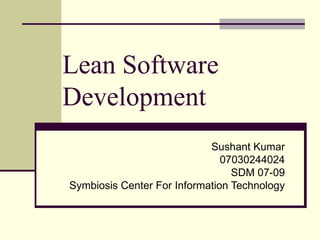Lean Software Development
•Download as PPT, PDF•
14 likes•8,848 views
this is just the brief introduction to the 7 lean software development principles
Report
Share
Report
Share

More Related Content
What's hot
What's hot (20)
Agile vs Waterfall Project Management Presentation

Agile vs Waterfall Project Management Presentation
Agile-overview: Agile Manifesto, Agile principles and Agile Methodologies

Agile-overview: Agile Manifesto, Agile principles and Agile Methodologies
Viewers also liked
Viewers also liked (20)
"Lean software development: discovering waste" by Mary Poppendieck

"Lean software development: discovering waste" by Mary Poppendieck
Introduction to Agile and Lean Software Development

Introduction to Agile and Lean Software Development
Similar to Lean Software Development
Similar to Lean Software Development (20)
The app trail how ideas move out of the drawing board onto the app store

The app trail how ideas move out of the drawing board onto the app store
Modern Agile – What's It Good For? - Jacob Creech - AgileNZ 2017

Modern Agile – What's It Good For? - Jacob Creech - AgileNZ 2017
PM Podcast 186 - Agile Manifesto for Project Managers

PM Podcast 186 - Agile Manifesto for Project Managers
How to Implement Agile Methodology | 12 Principles of Agile | Implementing Ag...

How to Implement Agile Methodology | 12 Principles of Agile | Implementing Ag...
A Practical Approach to Agile Adoption - Case Studies from Egypt by Amr Noama...

A Practical Approach to Agile Adoption - Case Studies from Egypt by Amr Noama...
Using Cost of Delay to de-scale your organisation through decentralised decis...

Using Cost of Delay to de-scale your organisation through decentralised decis...
Accelerating Business Growth with Agile Software Delivery.pdf

Accelerating Business Growth with Agile Software Delivery.pdf
ADDO19 - Automate or not from the beginning that is the question

ADDO19 - Automate or not from the beginning that is the question
Agile Development MethodologiesThree CommunitiesProjec.docx

Agile Development MethodologiesThree CommunitiesProjec.docx
Making IT Work for Your Business - 4 Key Concepts to Get the Most Out of Your...

Making IT Work for Your Business - 4 Key Concepts to Get the Most Out of Your...
Recently uploaded
Making communications land - Are they received and understood as intended? we...

Making communications land - Are they received and understood as intended? we...Association for Project Management
Explore beautiful and ugly buildings. Mathematics helps us create beautiful d...

Explore beautiful and ugly buildings. Mathematics helps us create beautiful d...christianmathematics
Recently uploaded (20)
Micro-Scholarship, What it is, How can it help me.pdf

Micro-Scholarship, What it is, How can it help me.pdf
General Principles of Intellectual Property: Concepts of Intellectual Proper...

General Principles of Intellectual Property: Concepts of Intellectual Proper...
UGC NET Paper 1 Mathematical Reasoning & Aptitude.pdf

UGC NET Paper 1 Mathematical Reasoning & Aptitude.pdf
Making communications land - Are they received and understood as intended? we...

Making communications land - Are they received and understood as intended? we...
Explore beautiful and ugly buildings. Mathematics helps us create beautiful d...

Explore beautiful and ugly buildings. Mathematics helps us create beautiful d...
ICT Role in 21st Century Education & its Challenges.pptx

ICT Role in 21st Century Education & its Challenges.pptx
Jual Obat Aborsi Hongkong ( Asli No.1 ) 085657271886 Obat Penggugur Kandungan...

Jual Obat Aborsi Hongkong ( Asli No.1 ) 085657271886 Obat Penggugur Kandungan...
Food safety_Challenges food safety laboratories_.pdf

Food safety_Challenges food safety laboratories_.pdf
Kodo Millet PPT made by Ghanshyam bairwa college of Agriculture kumher bhara...

Kodo Millet PPT made by Ghanshyam bairwa college of Agriculture kumher bhara...
Salient Features of India constitution especially power and functions

Salient Features of India constitution especially power and functions
HMCS Max Bernays Pre-Deployment Brief (May 2024).pptx

HMCS Max Bernays Pre-Deployment Brief (May 2024).pptx
Lean Software Development
- 1. Lean Software Development Sushant Kumar 07030244024 SDM 07-09 Symbiosis Center For Information Technology
- 6. Seeing Waste Defects Defects Task switching Motion Waiting for the information Waiting Building the wrong thing Transportation Extra features Overproduction Paperwork or excess documentation Extra processing Partially work done Inventory Wastes of Software Development Wastes of Manufacturing
- 7. The biggest source of waste
- 8. Eliminate waste By using Traditional Value Stream
- 16. Value those who add value
- 23. THANKS